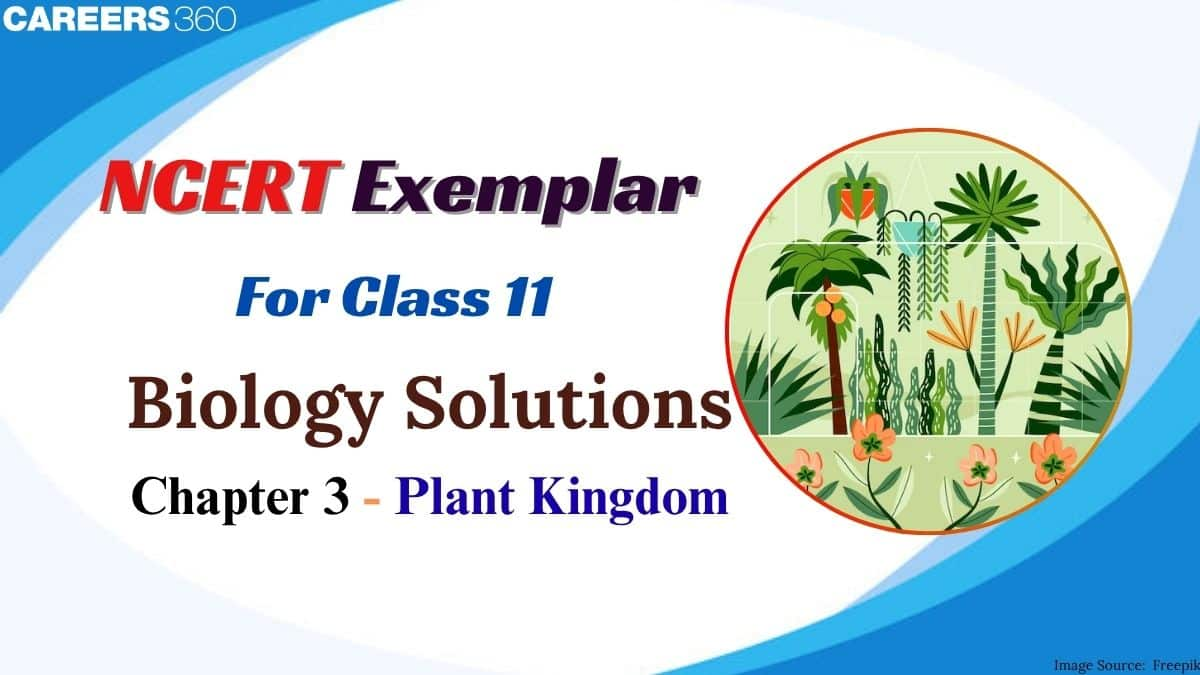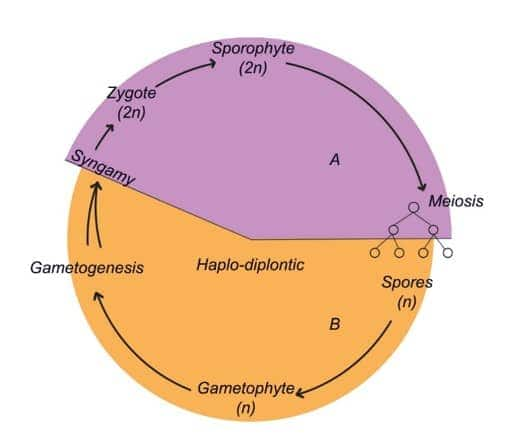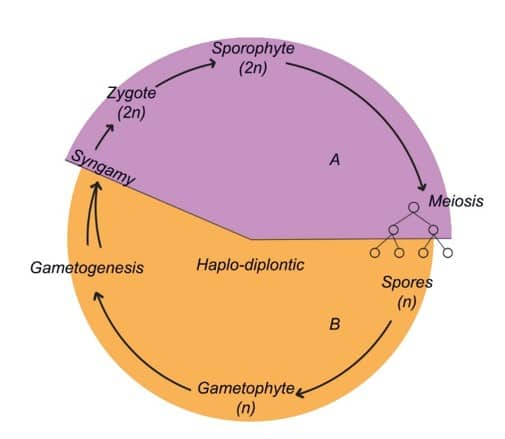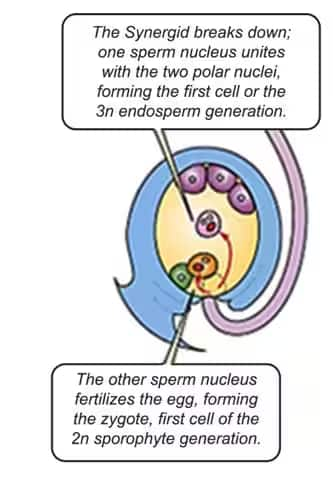NCERT Exemplar Class 11 Biology Solutions Chapter 3 Plant Kingdom
The NCERT Exemplar Class 11 Biology Solutions Chapter 3 Plant Kingdom are designed by experts to help students in their studies. The Plant Kingdom chapter covers the characteristics and life cycles of algae, bryophytes, pteridophytes, gymnosperms, and angiosperms. It also includes topics like taxonomy and alternation of generations. These solutions provide detailed explanations of the topics and help students prepare for their school exams and entrance tests. Students can improve their understanding with the NCERT Exemplar Solutions and boost their confidence.
This Story also Contains
- Access the NCERT Exemplar Class 11 Biology Solutions Chapter 3 (Multiple Choice Questions)
- Get Answers to Plant Kingdom Class 11 NCERT Exemplar (Very Short Questions)
- Find Answers to the Plant Kingdom Class 11 NCERT Exemplar (Short Questions)
- Find Answers to the Plant Kingdom Class 11 NCERT Exemplar (Long Questions)
- Approach to Solve NCERT Exemplar Class 11 Biology Solutions Chapter 3
- Main topics of Plant Kingdom Class 11 NCERT Exemplar
- Advantages of NCERT Exemplar Class 11 Biology Chapter 3 Solutions
- Important Questions from NCERT Exemplar Class 11 Biology Solutions Chapter 3
- NCERT Exemplar Class 11 Biology Solutions Chapter Wise

Different kinds of questions are included in the Plant Kingdom Class 11 NCERT Exemplar to gain clarity. Well-labelled diagrams are also included by subject experts to help students increase their knowledge. The solutions are an excellent study material for the students to perform well in their exams. Doing regular practice of the NCERT Exemplar Class 11 Biology Solutions Chapter 3 makes students understand the classification of the plant kingdom in detail.
Access the NCERT Exemplar Class 11 Biology Solutions Chapter 3 (Multiple Choice Questions)
This section includes MCQs, short, and long answer questions to help students review their understanding. Practising the Plant Kingdom Class 11 NCERT Exemplar also builds time management and improves answer writing in exams.
Question:1
What are Cyanobacteria classified under?
(a) Plantae
(b) Protista
(c) Algae
(d) Monera
Answer:
The answer is option (d) Monera.
Question:2
What is the term for the fusion of two motile gametes that are dissimilar in size?
(a) Anisogamy
(b) Isogamy
(c) Oogamy
(d) Zoogamy
Answer:
The answer is option (a) Anisogamy.
Explanation: The size of gametes is dissimilar in accordance to each other and hence is termed as ‘Anisogamy’.
Question:3
Holdfast, stipe, and frond constitute the plant body in the case of
(a) Phaeophyceae
(b) All of the above
(c) Rhodophyceae
(d) Chlorophyceae
Answer:
The answer is option (a) Phaeophyceae.
Question:4
A plant shows the thallus level of organisation. It shows rhizoids and is haploid. It needs water to complete its life cycle because the male gametes are motile. Identify the group to which it belongs
(a) Pteridophytes
(b) Bryophytes
(c) Monocots
(d) Gymnosperms
Answer:
The answer is option (b) Bryophytes.
Explanation: Plants from monocots and gymnosperms do not require any water for the process of fertilisation. Bryophytes and pteridophytes require water for fertilisation. But pteridophytes have actual roots. Hence, b is the correct choice.
Question:5
A Prothallus is
(a) A structure in pteridophytes formed before the thallus develops
(b) A sporophytic free-living structure formed in pteridophytes
(c) A primitive structure formed after fertilisation in pteridophytes
(d) A gametophyte free-living structure formed in pteridophytes
Answer:
The answer is option (d), A gametophyte free-living structure formed in pteridophytes.
Question:6
Plants of this group are diploid and well-adapted to extreme conditions. They grow bearing sporophylls in compact structures called cones. The group in reference is
(a) Monocots
(b) Gymnosperms
(c) Pteridophytes
(d) Dicots
Answer:
The answer is option (b) Gymnosperms.
Explanation: Cones are a primary feature of gymnosperms. Furthermore, gymnosperms are admirably adapted to extreme conditions.
Question:7
The embryo sac of an Angiosperm is made up of
(a) 8 cells
(b) 7 cells and 7 nuclei
(c) 8 nuclei
(d) 7 cells and 8 nuclei
Answer:
The answer is option (d), 7 cells and 8 nuclei.
Explanation: The seven cells are one egg cell, two synergids, three antipodal cells, and one secondary nucleus. The secondary nucleus consists of two nuclei, while the other cells consist of one nucleus each.
Question:8
If the diploid number of a flowering plant is 36. What would be the chromosome number in its endosperm?
(a) 36
(b) 54
(c) 18
(d) 72
Answer:
The answer is option (b) 54.
Explanation: Endosperm is formed through the fusion of a haploid male gamete and a diploid secondary nucleus. Consequently, the endosperm has a triploid nucleus, which will have three times the number of chromosomes as in a haploid nucleus.
Question:9
Protonema is
(a) Haploid and is found in mosses
(b) Haploid and is found in pteridophytes
(c) Diploid and is found in pteridophytes
(d) Diploid and is found in liverworts
Answer:
The answer is option (a), Haploid, and is found in mosses.
Question:10
The giant Redwood tree (Sequoia sempervirens) is a/an
(a) Gymnosperm
(b) Free fern
(c) Pteridophyte
(d) Angiosperm
Answer:
The answer is option (a) Gymnosperm.
Explanation: Redwood trees are a Gymnosperm that have earned many labels; known as the tallest tree, oldest tree, largest by trunk volume, etc.
Get Answers to Plant Kingdom Class 11 NCERT Exemplar (Very Short Questions)
Very short answer-type questions aim to check knowledge of key terms, definitions, and one-line facts. Plant Kingdom Class 11 NCERT Exemplar is memory-based and helps in strengthening the foundation of the subject.
Question:1
Answer:
In Phaeophyceae or Brown Algae, mannitol is the reserve food material used by them.
Question:2
Give an example of plants with
(a) Haplontic life cycle
(b) Diplontic life cycle
(c) Haplodiplontic life cycle
Answer:
(a) Volvox, Spirogyra, and some types of Chlamydomonas
(b) Fucus (this is an alga)
(c) Kelps, Polysiphonia, Ectocarpus, etc.
Question:3
Answer:
In lower plants like bryophytes and some algae, rhizoids act as root-like structures for absorption and anchorage.
Question:4
Most algal genera show a haplontic lifestyle. Name an alga that is
(a) Haplodiplontic, (b) Diplontic.
Answer:
(a) Ectocarpus and Polysiphonia are Haplodiplontic
(b) Fucus is Diplontic.
Question:5
In Bryophytes, male and female sex organs are called ____ and ____.
Answer:
Antheridium (male sex organ), archegonium (female sex organ).
Find Answers to the Plant Kingdom Class 11 NCERT Exemplar (Short Questions)
Short-answer type questions focus on brief explanations of concepts, differences, and examples. The NCERT Exemplar Class 11 Biology Chapter 3 helps students to express their understanding with clarity.
Question:1
Why are bryophytes called the amphibians of the plant kingdom?
Answer:
Bryophytes require water for one stage of their life cycle, i.e., in the process of reproduction. Similarly, amphibians, too, require water to lay their eggs and their tadpoles grow and develop in water. Thus, bryophytes are called the amphibians of the plant kingdom.
Question:2
Answer:
Yes, heterospory has evolutionary significance in the plant kingdom because heterospory is the formation of two types of spores, differentiating in size and sex: microspores and megaspores. Microspores are the male who are smaller in size, and megaspores are the female who are larger. In Pteridophytes, the microspores and megaspores sprout together to give rise to male and female gametophytes. In the end, the zygote matures in the female gametophyte. Seeds make it possible for gymnosperms and angiosperms to survive long periods of hostile conditions. Seeds have also made it possible for them to spread to different geographical areas by seed dispersal.
Question:3
Answer:
In Selaginella, heterospory and partial retention of megaspore inside the megasporangium show a precursor to seed habit. However, Selaginella lacks integuments and a seed coat, and the embryo is not fully retained on the parent sporophyte. Thus, it falls short of true seed habit.
Question:4
Answer:
Cycas is the only living species in the family Cycadaceae. All other species of the Cycadaceae family are extinct, as of now. The Cycas plant is often considered the living fossil and the plant of the Old World, because it is found only at those places where some of the oldest rocks in the world are found. Because of these reasons, Cycas is also known as the ‘relic of the past’.
Besides that, Cycas resembles more with Pteridophytes than any Gymnosperms. This proves a phylogenetic relationship between Pteridophytes and Gymnosperms.
Some features of Cycas which prove this are as follows: -
In Cycas, the seeds are shed when the embryo is still developing or mature. In gymnosperms, seeds are shed solely when the embryo is mature.
The megasporophylls look like a leaf.
Even though the pollen tubes are present, the male gametes are flagellate.
The leaf base is persistent.
Circinate ptyxis, which is similar to that in Pteridophytes.
Question:7
Comment on the lifecycle and nature of a fern prothallus.
Answer:
Fern, which is a type of pteridophyte, reveals a haplodiplontic state. In this situation, both the stages of gametophytic and sporophytic stages are multicellular. The diploid sporophyte is represented by a prepotent and independent, photosynthetic, vascular plant body. The haploid gametophyte is also independent, but its duration of life is shorter than that of the sporophytes.

Question:8
How are the male and female gametophytes of pteridophytes and gymnosperms different from each other
Answer:
Pteridophytes | Gymnosperms | ||
(a) | Flagellated male gamete | (a) | Non-flagellated male gamete |
(b) | Archegonia with neck canal cells | (b) | Neck canal cells are absent |
(c) | Pollen tubes are not formed | (c) | Pollen tubes are formed |
(d) | Water is essential for fertilisation | (d) | Water is not essential |
The size of the gametophyte of pteridophytes is quite large compared to the gymnosperm's gametophytes. Gametophytes of pteridophytes are photosynthetic, while gametophytes of gymnosperms are not photosynthetic.
Question:9
Answer:
Mycorrhiza is a symbiotic association of a fungus and roots, seen in Pinus. Coralloid roots occur in Cycas, where cyanobacteria like Nostoc or Anabaena fix nitrogen.
Find Answers to the Plant Kingdom Class 11 NCERT Exemplar (Long Questions)
The detailed answers to the long Questions are given below. Having an understanding of how to write long answers is important to score well in exams.
Question:1
Gametophyte is a dominant phase in the life cycle of a bryophyte. Explain.
Answer:
The dominant phase in bryophytes is represented by gametophytic plants. The gametophyte is self-reliant, photosynthetic, and erect. Antheridia and archegonia are developed and found on the gametophyte. These male and female organs are multicellular. The Antheridia and Archegonia carry the male and female gametes. The antheridium produces biflagellate antherozoids, while the archegonium produces a single egg. Water helps to carry the antherozoids to the archegonium. The antherozoids are flagellate, which gives them the feature of being motile. After the process of fertilisation, the zygote is formed. The zygote develops into a multicellular figure called a sporophyte.
The sporophyte in bryophytes is comparatively smaller and is not self-reliant. The sporophyte is attached to the gametophyte and gets its nutrition from the gametophyte. The gametophyte has control over the life cycle of a bryophyte in every phase. The gametophyte is self-independent and photosynthetic. The size of the gametophyte is larger than compared of the sporophyte. Also, the sporophyte is not independent and holds on to the gametophyte for nutrition.
Question:2
Answer:
Pteridophyte and Bryophyte both reveal a haplodiplontic life cycle. The diploid phase is not independent in bryophytes; however, it is independent in the case of pteridophytes. Furthermore, the sporophyte is more clearly visible in the case of pteridophytes than in bryophytes.

Question:3
Lichen is usually cited as an example of ‘symbiosis’ in plants where an algal and a fungal species live together for their mutual benefit. Which of the following will happen if algal and fungal partners are separated from each other?
(a) Both will survive and grow normally and independently of each other.
(b) Algal components will survive while the fungal component will die.
(c) Both will die
(d) The Fungal component will survive while the algal partner will die.
Based on the answer, how do you justify this association as symbiosis?
Answer:
Option(c) is the correct one, i.e., both will die.
Explanation: The process of ‘symbiosis’ explains that the plant and the fungus, which are growing together, depend on each other for nutrients, and if they are bound to get separated, they will both die because they are codependent.
Question:4
Answer:
In the process of double fertilisation in case of angiosperms, one male gamete fuses with the female gamete, and the second male gamete fuses with the secondary nucleus. This fusion of the male and female gametes results in the formation of the zygote. And the fusion between the second male gamete and the secondary nucleus results in the outcome of the primary endosperm nucleus. Since two occurrences of fusion of nuclei take place, it is called double fertilisation. The following figures show double fertilisation:

Question:5
Draw labelled diagrams of the following:
(a) Female and male thalli of a liverwort.
(b) Gametophyte and sporophyte of Funaria.
(c) Alternation of generation in Angiosperms.
Answer:
(a) Female and male thallus of a liverwort:

(b) Funaria, gametophyte and sporophyte: -

(c) Alternation of generation in Angiosperm:

Approach to Solve NCERT Exemplar Class 11 Biology Solutions Chapter 3
Given below are some of the most important steps students can follow to solve the questions of this chapter effectively.
Students should begin by studying the hierarchical system of classification of plants. It includes algae, bryophytes, pteridophytes, gymnosperms, and angiosperms, along with characteristics, life cycles, and reproduction patterns.
They should focus on comparing different groups using features such as the dominant phases and modes of reproduction.
The use of diagrams is important because they play an important role in labelling and identifying structures.
They should solve both direct and application-based questions, given in the NCERT Exemplar Class 11 Biology Chapter 3.
Regular revision and continuous practice will improve their conceptual clarity and make them ready for exams.
Also, read the NCERT Solution subject-wise
Main topics of Plant Kingdom Class 11 NCERT Exemplar
This chapter focuses on the classification and features of different plant groups found in the Plant Kingdom. Given below are the main topics covered in this chapter. Questions about all these topics are covered in the NCERT Exemplar Class 11 Biology Chapter 3.
Algae: types and characteristics
Bryophytes and their life cycle
Pteridophytes and reproduction
Angiosperms: monocots vs dicots
Alternation of generations in plants
NCERT Exemplar Class 11 Solutions
Advantages of NCERT Exemplar Class 11 Biology Chapter 3 Solutions
The chapter Plant Kingdom introduces students to the classification, structure, and life cycles of various plant groups found on the earth. After studying the chapter, they should solve the exemplar problems regularly.
- NCERT Exemplar Class 11 Biology Chapter 3 Solutions include different types of questions, such as MCQs, short, and long, related to the plant classification system.
- Students should improve conceptual learning through well-detailed answers on algae, bryophytes, pteridophytes, and angiosperms.
- They can improve their problem-solving skills and boost confidence in answering questions during exams.
- Students will also understand how to write answers in the exam by going through the exemplar solutions.
- The exemplar solution includes diagram-based and application-based questions, which are useful for NEET and board exams.
Important Questions from NCERT Exemplar Class 11 Biology Solutions Chapter 3
The questions given below helps students to test their understanding of key concepts related to plant groups and their characteristics. To solve more questions, students can use the NCERT Exemplar Class 11 Biology Chapter 3 as a guide.
Question 1: The first living beings on Earth were anaerobic because
Options:
There was no oxygen in the air
Oxygen damages proteins
Oxygen interferes with the action of ribozymes
They evolved in the deep sea
Answer: The correct answer is option 1) There was no oxygen in the air
Explanation:
The first living beings on Earth were likely anaerobic organisms because the Earth's atmosphere lacked oxygen during its early stages. This period, known as the Precambrian or Archean era, lasted for billions of years before oxygen began to accumulate in the atmosphere through the process of photosynthesis by cyanobacteria. Anaerobic organisms, which do not require oxygen for their metabolism, were able to thrive in this oxygen-free environment.
Question 2. If the diploid number of a flowering plant is 36. What would be the chromosome number in its endosperm?
Options:
- 36
- 54
- 18
- 72
Answer: The correct answer is option 2) 54
Explanation:
Endosperm is formed through the fusion of a haploid male gamete and a diploid secondary nucleus. Consequently, the endosperm has a triploid nucleus, which will have three times the number of chromosomes as in a haploid nucleus.
Question 3. Plants of this group are diploid and well-adapted to extreme conditions. They grow bearing sporophylls in compact structures called cones. The group in reference is
Options:
- Monocots
- Gymnosperms
- Pteridophytes
- Dicots
Answer: The correct answer is option 2) Gymnosperms
Explanation:
Cones are a primary feature of gymnosperms. Furthermore, gymnosperms are admirably adapted to extreme conditions. The plants that produce seeds are called gymnosperms, although they don't have fruits like angiosperms do. These plants generate a cone-like structure at the terminal of stalks or on the surface of scales or leaves.
Must Read NCERT Notes subject-wise
NCERT Exemplar Class 11 Biology Solutions Chapter Wise
The NCERT exemplar chapter-wise solutions are given below for quick and easy access-
Frequently Asked Questions (FAQs)
The topics covered in the NCERT Exemplar Class 11 Biology Solutions Chapter 3 Plant Kingdom are given below:
Algae
Bryophytes
Pteridophytes
Gymnosperms
Angiosperms
Plant life cycles and alternation of generations
NCERT Exemplar provides detailed explanations, conceptual clarity, and practice questions that help students understand plant classification, adaptations, and life cycles. It also prepares students for competitive exams like NEET and JEE.
The important questions of NCERT Exemplar Class 11 Biology Solutions Chapter 3 Plant Kingdom are provided below:
Differences between plant groups (e.g., bryophytes vs pteridophytes).
Characteristics of gymnosperms and angiosperms.
Steps of alternation of generations
Plants alternate between:
Gametophytic stage: Haploid; produces gametes through mitosis.
Sporophytic stage: Diploid; produces spores through meiosis. This alternation ensures genetic variation
Major characteristics include:
Algae: Aquatic and photosynthetic.
Bryophytes: Amphibians of the plant kingdom; non-vascular.
Pteridophytes: First vascular plants with differentiated structures.
Gymnosperms: Naked seeds, no flowers.
Angiosperms: Flowering plants with fruits
Algae: Used as food (e.g., Spirulina), fertilizers, and in industries for agar production.
Bryophytes: Serve as soil binders and are used as fuel (peat moss)
Adaptations include:
Rhizoids for anchorage.
Moist environments to facilitate water absorption and reproduction.
Protective structures like archegonia to prevent desiccation
Courses After 12th
Applications for Admissions are open.
As per latest syllabus. Physics formulas, equations, & laws of class 11 & 12th chapters
JEE Main Important Chemistry formulas
Get nowAs per latest syllabus. Chemistry formulas, equations, & laws of class 11 & 12th chapters
JEE Main high scoring chapters and topics
Get nowAs per latest 2024 syllabus. Study 40% syllabus and score upto 100% marks in JEE
JEE Main Important Mathematics Formulas
Get nowAs per latest syllabus. Maths formulas, equations, & theorems of class 11 & 12th chapters
